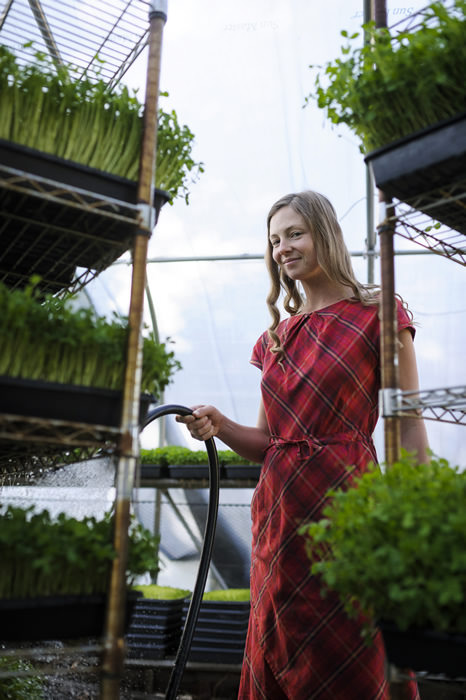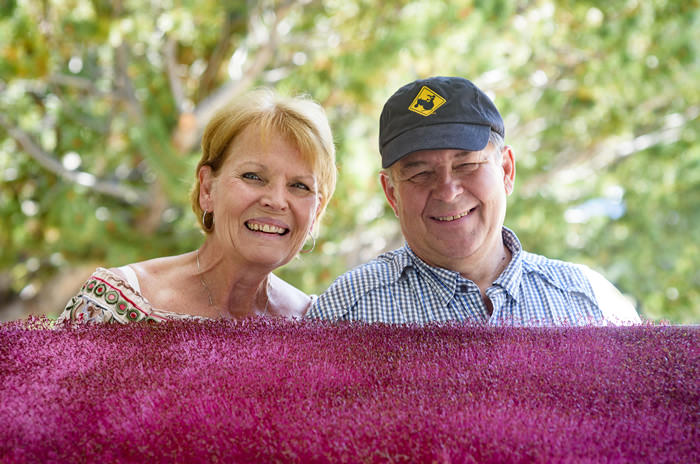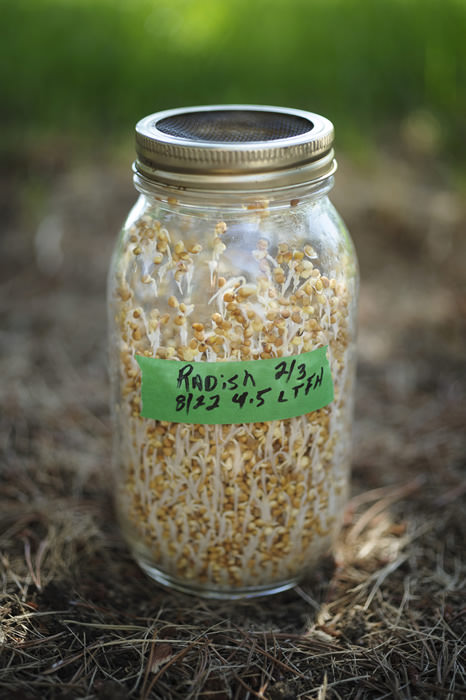meet the farmer
SHORT AND SWEET
With their high nutrient content, microgreens should be a part of every meal.
WRITTEN BY CHRISTINA NELLEMANN
PHOTOS BY CANDICE NYANDO
Those delightful dashes of tender shoots scattered on top of your restaurant salad or sandwich are so much more than colorful vegetable confetti. Smaller than baby greens, microgreens actually contain more nutrients than their larger counterparts or mature plants and have become an important ingredient to integrate into a healthy diet.
“If you look at the increase in all the health issues we’ve had over the years, it’s been from the time we’ve had access to processed foods,” says Kathleen Johnson, co-owner of Tahoe Living Greens in Reno, with her husband, Rick. “Rick and I got into microgreens because of the health benefits.”
Microgreens are tiny, immature plants that have been growing for about seven to 10 days and include only the first set of their leaves. Grown in either soil or on special growing mats, microgreens can be harvested quickly for use at home or by restaurant chefs. Contrary to popular belief, microgreens are not sprouts. Sprouts are partially germinated seeds in which the seed, stem, and root are eaten. Microgreens are cut with scissors above the root, and only the stem and leaves are consumed. Their growing conditions do not encourage the development of pathogens that can affect sprouts.
Because the tiny plants have not yet sent their energy into the roots and main plants, microgreens are little nutrient bombs. According to the Journal of Agricultural and Food Chemistry and Qin Wang, an assistant professor at the University of Maryland in College Park, research on microgreens found that the little plants had four to 40 times more concentrated nutrients than their corresponding mature plants. The levels of vitamins K, C, E, lutein, and beta-carotene were evaluated and found to be highest in immature red cabbage, green daikon radish, cilantro, and garnet amaranth microgreens.

Garage gardening
Just as their name implies, the systems for growing plentiful microgreens also can be small scale; the plants don’t take up acres of land. The Johnsons both grew up farming grain and cattle in rural Minnesota and now grow microgreens in their South Reno garage.
“When we moved here, we originally grew vegetables in a greenhouse in the backyard,” Rick says. “But with the 60- to 90-mile-per-hour winds we get, I didn’t want to go to Sparks to work on my greenhouse. Microgreens seemed like the answer since they are both unique and healthy.”
“We can grow an incredible amount of microgreens in such a small space in our garage,” Kathleen says. “It’s a very interesting concept of growing food.”
Their insulated garage contains a microgreen factory complete with multi-tiered shelves covered with grow lights and filled with trays growing masses of little plants on special growing mats. The automatic watering system doesn’t spray the plant, but rather it spits out a little water toward the bottom of the mat and the roots.
The Johnsons grow dozens of microgreens such as spicy radish, broccoli, French garden, purple kohlrabi, alfalfa, and sunflower. They are USDA Good Agricultural Practices certified and only buy organic, non-GMO seeds from Sproutpeople in San Francisco, Calif., and Mountain Valley Seed Co. in Salt Lake City, Utah.
The Johnsons also diversify the customers to whom they sell. You can find their microgreens at the Carson Farmers’ Market in Carson City and at The Grove at South Creek in Reno. Cherry Bomb Catering in Reno uses their microgreens for its dishes, and the Johnsons also provide greens to Renown Health.

Giving peas a chance
“People might not understand what microgreens are at first, but you don’t need to know what they are to enjoy them,” says Shelly Goodin, owner of New Harvest Farm in Reno. “Eating one handful of pea shoots is like eating 50 unique plants.”
Goodin specializes in pea shoots for restaurants such as Brasserie Saint James and Great Full Gardens, as well as the Great Basin Community Food Co-op and DROPP program, all in Reno. Goodin grows her tiny jungles of pea shoots in 120 trays filled with soil in an outdoor greenhouse; the crops are in constant rotation and are harvested every 10 days. Since peas are cold-weather plants, they are able to withstand this area’s winters, yet they still do well in the hot summer.
In addition, because the plants grow so quickly, chefs don’t have to wait on maturing vegetables or out-of-state producers in order to receive fresh products. Goodin is able to deliver fresh greens to her chefs two days each week.
“Pea shoots are kind of sweet and a real crowd pleaser,” Goodin says. “Not only are they young and fresh, but they are so full of life and vitality.”

Super shoots
The way microgreens are grown can be just as diverse as the farmers who grow them. Todd Karol and Stacie Schultze, owners of Little Roots Farm, supplement their vegetable production with microgreens grown in a geodesic dome on their biointensive Truckee farm. Their microgreens primarily make an appearance at the Tahoe City Farmers’ Market and the Truckee Community Farmers’ Market, but they also are served at Old Town Tap and by EATS Cooking Co. in Truckee.
“Our main goal is to supply our community with a nutritional supergreen,” Karol says. “We really focus on the farmers’ markets and provide the most nutrients we can.”
Little Roots Farm also grows its microgreens in soil, and its daikon radish, broccoli, arugula, basil, and sunflower shoots are popular choices. For extra beauty, the microgreens sometimes are mixed with edible flowers.
“We feel that growing in soil is the most natural way to have a high-end microgreen,” Karol says. “You are harvesting all the soil and sun energy into one seed.”
Small plants, big plans
Brian Harasha keeps his microgreens alive right up until they hit the plate. Harasha, owner of Jazi’s Greenz in Carson City, delivers his trays full of microgreens sitting on coco coir mats to restaurants such as Café at Adele’s, The Union, Sassafras, and Battle Born Social, all in Carson City.
“People who struggle to eat a lot of vegetables only need to eat a handful of microgreens and they’ll get the same nutritional value as those vegetables,” Harasha says.
Sitting in a spare bedroom in his house, the trays (with a separate watering tray below each one) are filled with micro herbs, purple kohlrabi, mustard greens, and curled cress. Harasha always is impressed that he can grow a pound of food a week at such a fast pace — a tray of radishes takes only three days.
Harasha, a former wildlife biologist, takes his microgreens a step further and has designed microgreen centerpieces for weddings and special events. Different types of amaranth create a mural of colors for a reception table.
Named after Harasha’s daughter, Jazi’s Greenz is the face of young farmers in the area. He has expanded his business to include a backyard and garage full of growing towers with Italian and Thai basil, tomatoes, peppers, and even plants that thrive on salt water. He also wants to help develop underutilized retail buildings into growing facilities.
“Ideally, what I really wanted to do was provide for my community,” Harasha says.
Christina Nellemann is a writer living in Washoe Valley. She sampled several microgreens while touring the farms, and her favorites were the curled cress and pea shoots.
Resources
Jazi’s Greenz
Basil, broccoli, bell peppers, mâche, curled cress
1109 Patton St., Carson City
406-581-2884 • Jazigreenz.com
Little Roots Farm
Arugula, basil, sunflower shoots, daikon radish
11443 Alder Drive, Truckee
530-214-9213 • Littlerootsfarm.com
New Harvest Farm
Pea shoots
2149 Westfield Ave., Reno
775-229-6855 • Facebook.com/newharvestfarm
Resort at Squaw Creek/Rooftop Roots
Pea shoots, mizuna, broccoli
400 Squaw Creek Road, Olympic Valley
530-583-6300 • Destinationhotels.com/squawcreek
Tahoe Living Greens
Red garnet amaranth, garlic chives, broccoli
905 Creek View Drive, Reno
309-287-7550 • Tahoelivinggreens.com
Recipe
TLG Cream of Broccoli Soup
(courtesy of Kathleen Johnson, owner, Tahoe Living Greens in Reno. Serves 4)
2 tablespoons avocado oil
1 medium onion, chopped
1 carrot, chopped
1 celery stalk, chopped
1 to 3 medium potatoes, peeled and chopped (more potatoes equal thicker soup)
4 cups chicken stock
1 tablespoon salt (add more to taste)
1 tablespoon pepper (add more to taste)
5 ounces Tahoe Living Greens microgreen broccoli (save some for garnish)
¾ cup heavy cream
½ teaspoon butter
Thyme or nutmeg for garnish
In a large pot, sauté onion, carrot, and celery in avocado oil over medium-high heat until tender. Add potatoes, chicken stock, and salt and pepper, to taste. Simmer 5 minutes. Add broccoli microgreens and continue simmering until potato is tender.
Purée in blender or food processor. Return to pot and add cream; heat to simmer. Garnish with nutmeg or thyme, butter, and microgreen broccoli. Serve with pita chips.
From left, Jan Solberg, Brenda Horton, Susan Hamarlund, and Sue Higgins of the Ladies Auxiliary of the Fleet Reserve Association serve muffins to veterans at Carson City’s Veterans Memorial Hall


